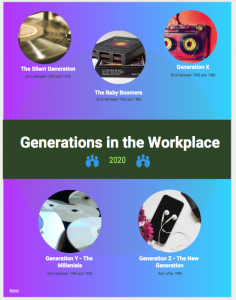“Don’t make fun of your mother for needing help with her computer. She taught you how to use a spoon!”
The popular online meme’s got a point. In the ever-changing tech world, the younger generation is quick to learn and adapt to every new gadget. But as the new extremely tech-savvy generations take over the workforce, the older age groups can still remain relevant, useful, and employable.
The modern workplace is a unique environment. For the first time in history, five generations are working together. The demographic diversity comes with challenges in terms of employee engagement, technology advancement and implementation, and overall company culture. However, the variety of backgrounds, experiences, and distinctive qualities each generation brings to the mix can increase productivity and further success of a company. It’s not a secret that creating a team in which people work well together is good for business.
How do we close the generation gap in the workplace, while using diversity to our advantage?
First, let’s see with whom we’re working here.
The boundaries of each generation are somewhat flexible and individual characteristics within each group vary greatly. However, similar experiences within each generation’s lifetime result in general characteristics unique to each group.
Understanding the uniqueness of each generation in light of these characteristics can help close the gap and enhance a company’s culture. Basing company business strategies on the strengths and weaknesses of its employees can ensure full utilization of resources.
Let’s examine these general characteristics of each group.
The Traditionalists (The Silent Generation).
Strengths:
Even though employees in this group are a minority in the workplace now, due to their age and experience they tend to be in high leadership positions. They are seasoned and knowledgeable when it comes to specifics of their industries. Having been through some adversities throughout their lifetimes, they are resilient, hardworking, and resourceful. Their work ethic values hard work and respect for authority.
Weaknesses:
Traditionalists stick to what they know has worked for decades and are resistant to change. Such an attitude can create difficulties in the modern-day ever-moving and ever-changing workplace. This group is the least tech-savvy.
Workplace engagement:
In the world of youth and face-paced digital innovation, it’s important to engage those with the most experience because real-world knowledge is a valuable tool in all aspects of the business. Traditionalists prefer face-to-face communication, so it’s better to talk to them in person as opposed to through email or chat. When loyalty is an important aspect of a task, traditionalists are the go-to people. Their knowledge of the pre-tech world is also valuable. Pairing traditionalists up with younger employees for certain projects can definitely benefit both people and the company and help close the generational gap.
Baby Boomers
Strengths:
While the Boomers are still the largest group of the population, they are no longer the majority in the workforce. Working as a bridge between the exiting traditionalists and the dominating Generation Xs and Ys, the Boomers combine the strong work ethic of the past with the flexibility of younger age groups. The boomers are independent, yet team-oriented; they value collaboration. They are more adaptive and curious about technological innovation than traditionalists.
Weaknesses:
The boomers are new to the fast-paced tech world, so they might still be on the slower side when it comes to change and adaptation to new technology. As Chip Conley claims in his TED talk, their “digital intelligence” is lower than their “emotional intelligence.”
Workplace engagement:
Conley puts it best when he says “you can’t microwave emotional intelligence,” meaning that the human-to-human experience the baby boomers can provide is essential and irreplaceable. Putting this age group in charge when it comes to real-life communication is a great strategy to engage this generation and use the skills these employees possess most effectively. Baby boomers might not be great at all the ins and outs of the fast-paced tech world, but they are experts on human hearts and minds.
Generation X
Strength:
The second largest group in the workplace, this group has a good work ethic, is adaptive to change, possesses great problem-solving skills, and works well without supervision. This group is most connected to social media. Generation Xers are passionate about projects they care about and they value “flexibility, independence, recognition and constructive feedback in the workplace, which often makes them successful leaders,” as one researcher puts it.
Weaknesses:
Generation Xers’ weaknesses lie in their financial priorities as they have more responsibilities that require funding. With higher monetary expectations this group is most non-cost-effective for employers. Gen Xers also value efficiency over quality.
Workplace engagement:
To motivate Gen Xers in the workplace employers should cut back on micromanagement and explore the passions of these employees. Giving them projects they care about will ensure productivity and increase motivation. Because this group is the most connected on social media, especially older platforms such as Facebook and LinkedIn, using its expertise can benefit the employers greatly. Collaborating with both older and younger groups can also help close the generational gap.
Millennials
Strengths:
The largest group in the workforce the Millenials sometimes get a bad rep, but actually, come with many strengths. They are independent workers, adaptive to change, most educated, tech-savvy, experience-hungry, and are great revenue-generators for employers. Millennials are creative, energetic, and innovative. They tend to work for a purpose rather than for money, though with fewer financial responsibilities they are also better with money than Gen Xers.
Weaknesses:
Millennials tend to value social aspects overwork, less likely to work overtime, are less of team-players, and, most infamously, are often considered entitled.
Workplace engagement
Needless to say, millennial are tech people, so when looking for a team member to handle a tech-related project, a millennial is a great bet. To build on the millennial’s preference for social connections, an employer can put them in charge of networking events. Make sure to provide them with an excellent networking platform they can use to host the online gathering. Whenever some creative, out-of-the-box thinking is required, the millennials are, again, the best people for the job.
Generation Z
Strength:
The newest addition to the newest addition to the workforce, these youngsters are the future of it. They are the most tech-savvy and adaptive to change, creative, multi-tasking, self-learners, pragmatic, and entrepreneurial. They are rebellious to the old tradition. That makes the Gen Zs most creative and innovative as well. Passionate for causes, they are motivated and ambitious.
Weaknesses:
The rebellious nature of generation z could also be a weakness as it may at times get in the way of their work. They are the least loyal group and tend not to prioritize work over leisure.
Workplace Engagement
Since gen z is the most technologically advanced, these employees live for technology. One great way to engage them is to embrace new technology in the workplace. The tech world moves fast and it is important to keep up with it. The creative and pragmatic nature of gen zs makes them perform better in the environments that nurture those qualities, so allowing room for advancement and creativity is also essential. This generation values flexibility, so making room for that might also help efficiency.
Final Thoughts
Keeping the unique skills and characteristics of each generation in mind is important for employers. To ensure success it’s essential to create a company culture that builds onto these qualities, makes room for intergenerational communication, and what Conley calls “mutual mentorship.”
We can all learn from each other and collaboratively build on each other’s strengths. With older generations exiting the workforce, workplaces will see changes in terms of how they operate. Work culture will become more fast-paced, digitally-oriented, less traditional, and more flexible.
But if we don’t learn from older generations now we will miss the chance to absorb their expertise from the world before high-tech and social media.
Technology plays an essential role in the workplace. The younger generation got that part under control. But people are still indispensable. Human to human experience is still the central part of the business and we need those who have the most experience with it – the traditionalists, the baby boomers, and the Gen Xers – to pass their knowledge to the newer generations. Mutual mentorship and collaboration is the key to closing the generational gap and succeeding in a diverse workforce.







